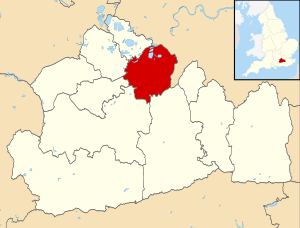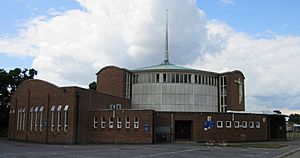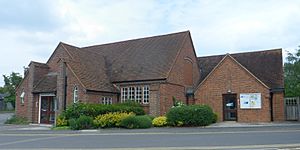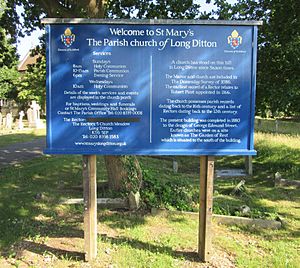List of places of worship in Elmbridge facts for kids
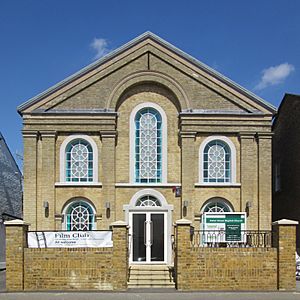
Elmbridge, a part of Surrey, England, is home to over 60 places where people have gathered to worship. These include churches, chapels, and meeting houses. About 48 of these buildings are still used for religious purposes by different Christian denominations. There are also two synagogues for Jewish people. Another 12 buildings used to be places of worship but are now used for other things.
Elmbridge is a mostly urban area with many towns and villages. Some very old churches, called parish churches, are still standing. However, most of the worship places were built more recently, in the 1800s and 1900s.
A census in 2011 showed that most people in Elmbridge are Christian. The Church of England, which is the official church of the country, has the most buildings. There are also many Roman Catholic churches. You can find chapels for other Christian groups like Methodists, Baptists, and the United Reformed Church throughout the area. Other groups include Christian Scientists, The Church of Jesus Christ of Latter-day Saints, Jehovah's Witnesses, the New Apostolic Church, Quakers, and Spiritualists. A Korean Presbyterian group meets in Weybridge, and synagogues serve Jewish people of both the Liberal and Reform traditions.
Many of these buildings are considered important by Historic England. They have "listed status," which means they are special because of their history or design. There are three levels of listed status:
- Grade I: Buildings that are extremely important.
- Grade II*: Buildings that are very important.
- Grade II: Buildings that are important.
As of 2001, Elmbridge had 8 Grade I buildings, 20 Grade II* buildings, and 462 Grade II buildings. Four churches are also "locally listed," meaning the local council thinks they are important to the area.
Contents
Exploring Elmbridge's Places of Worship
Elmbridge is in the northern part of Surrey, close to Greater London. It borders other areas like Richmond upon Thames, Kingston upon Thames, Mole Valley, Guildford, Woking, Runnymede, and Spelthorne.
The biggest towns in Elmbridge are Walton-on-Thames and Weybridge. Other towns and villages include West Molesey, Hersham, Cobham, Esher, Thames Ditton, Claygate, East Molesey, Long Ditton, Hinchley Wood, Oxshott, Stoke d'Abernon, and Weston Green. Elmbridge is known for being a wealthy area with a high quality of life. Its closeness to London and major airports makes it a popular, but expensive, place to live. In 2011, the total population was over 130,000 people.
Ancient Anglican Churches
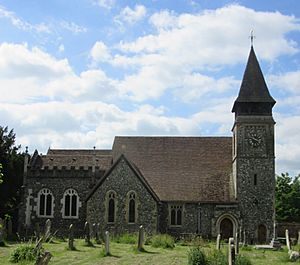
Some of the oldest churches in Elmbridge are parish churches in Cobham, Stoke d'Abernon, Thames Ditton, and Walton-on-Thames.
- In Cobham, St Andrew's Church has a tower from the Norman period (around 1066-1154). Other parts are from the 1200s, 1300s, and 1400s.
- St Mary's Church in Stoke d'Abernon is even older. Parts of it date back to the Saxon period (before 1066), and it even has old Roman bricks in its walls.
- St Nicholas' Church in Thames Ditton has a large tower and some windows from the 1200s. Its font (a basin for baptisms) is a century older.
- St Mary's Church in Walton-on-Thames also has some Norman-era parts, but most of it was built in the 1300s and 1400s.
- Esher's church, which existed by the late 1200s, was replaced around 1540 by the "delightful" St George's Church.
Victorian and 20th-Century Anglican Churches
Many Anglican churches in Elmbridge were built during the Victorian era (1837-1901). This was a time of fast population growth.
- The old church in Weybridge was replaced in 1848 by a new building designed by John Loughborough Pearson.
- St Mary's Church at Long Ditton replaced a 12th-century church nearby in 1878.
- St Mary's Church at East Molesey and St Peter's Church in West Molesey were almost completely rebuilt in the mid-1800s. Only the 16th-century tower of St Peter's remains from the older church.
- New churches were also built to serve growing communities. Holy Trinity Church at Claygate opened in 1840. A year earlier, a church with the same name was built in Hersham.
- Christ Church (1853–54) became the main parish church of Esher, taking over from St George's Church.
- St Paul's Church at East Molesey was built in 1854.
- St Mary's Church at Oatlands opened in 1861.
- In the 1900s, new churches opened in Weston Green (1939), Hinchley Wood, and southern Walton-on-Thames after World War II.
- Some smaller chapels, like a tin tabernacle in Esher and another in Downside, are still used. There's also a church in Whiteley Village, a special village built for retired people.
Roman Catholic Churches
The first main place for Roman Catholic worship in the area was Woburn Park, a country estate. It had a Catholic chapel, but it closed in 1815. That same year, a priest started a new Catholic group in his house in Weybridge.
- In 1836, a Catholic landowner built a new chapel. This small building later became part of a much larger church, St Charles Borromeo, which opened in 1881.
- In 1905, two new Catholic missions started in Elmbridge. A church was built in Walton-on-Thames in 1906, which was later replaced by the current St Erconwald's Church in 1937.
- In West Molesey, a house became a chapel in 1905, followed by a tin tabernacle, and then the current St Barnabas' Church, built in 1931.
- More churches were built after World War II in Cobham (1958), Hersham (1960), Claygate (1960–61), and Thames Ditton (1965).
- In Weybridge, a disused cinema was even turned into a second church, St Martin de Porres. Both St Charles Borromeo and St Martin de Porres churches closed in 1988. Money from their sale helped build a new church, the Church of Christ Prince of Peace, which opened in 1989. The old St Charles Borromeo church became a Korean Presbyterian church.
Methodist Churches
In 1947, there were Methodist chapels in Cobham, East Molesey, Esher, Walton-on-Thames, and Weybridge.
- In East Molesey, Methodists started meeting in a schoolroom in 1847. A wealthy Methodist, John Chubb, bought land for a chapel. A temporary building opened in 1867, followed by the current yellow-brick chapel in 1877.
- A Methodist chapel was built in Walton-on-Thames in the mid-1800s and was replaced by the current chapel in 1887.
- The brick chapel in Weybridge opened in 1903.
- The Methodist church in Esher opened in 1897 but closed by 2000.
- In Cobham, where John Wesley (the founder of Methodism) visited three times, a chapel opened in 1862. This was later replaced by a new church in 1964. In 2018, this church joined with Cobham United Reformed Church, and the old building is no longer used for worship.
United Reformed Churches
The United Reformed Church was formed in 1972 when the Congregational Church and the Presbyterian Church of England merged.
- Churches with a Congregational background are in Stoke d'Abernon, Thames Ditton, and Weybridge. Walton-on-Thames has a former Presbyterian church.
- The Thames Ditton church started in 1804, but the current building is from 1899. It closed for a while in the 1930s but reopened in 1947.
- A Congregational group started in Cobham in 1847. The current building at Stoke d'Abernon (Cobham United Church, shared with Methodists) is from 1963.
- In Weybridge, services began in a house's billiard-room in 1855, leading to the current large Gothic Revival church in 1864.
- Hersham also had a Congregational church built in 1844. Some members later started a second church nearby, which was replaced by a new building in 1983. This building is now used for other purposes.
- St Andrew's Presbyterian Church in Walton-on-Thames was built in 1931 as a church hall. It is still used for worship by the United Reformed Church.
Baptist Churches
A Baptist group started in Esher in 1852, and a chapel was built there in 1869.
- Four years later, members started a "branch chapel" in Oxshott.
- A tin tabernacle was built for Baptists in East Molesey in 1885, replaced by a permanent building the next year.
- In 1906, a chapel opened in Walton-on-Thames. Only the Walton-on-Thames church has been used continuously since it opened.
- Esher Baptist Church closed in 1977 but reopened in 1983 as Esher Green Baptist Church.
- The chapel in East Molesey closed in 1896, and a new church replaced it the following year, but this also closed in the 1930s.
- The Oxshott Baptist Chapel closed in 1980.
- Two Strict Baptist chapels in Claygate (1860) and Cobham (1873) are also no longer used for worship.
- In 1994, a new Baptist church started in Hersham, using an old Anglican church building.
Other Christian and Jewish Places of Worship
Other Christian groups in Elmbridge include:
- Spiritualists in Walton-on-Thames.
- Christian Scientists with churches and reading rooms in Claygate and Oatlands.
- Jehovah's Witnesses, whose Kingdom Hall in West Molesey opened in 1971.
- The Church of Jesus Christ of Latter-day Saints, whose meetinghouse in Hinchley Wood opened in 1978.
- The New Apostolic Church, which opened a building in Long Ditton in 1978.
- The Quaker meeting house in Esher is very old, built in the 1790s, and hasn't changed much.
- There are also several non-denominational churches, like Emmanuel Church in Hersham and Cornerstone The Church in Walton-on-Thames.
For the Jewish community, there is the Kingston Liberal Synagogue in Thames Ditton (following the Liberal tradition) and the North West Surrey Synagogue in Oatlands (following the Reform tradition).
Religious Beliefs in Elmbridge
The 2011 UK Census showed that out of 130,875 people in Elmbridge:
- 64.16% said they were Christian.
- 1.84% were Muslim.
- 1.22% were Hindu.
- 0.61% were Jewish.
- 0.52% were Buddhist.
- 0.4% were Sikh.
- 0.34% followed another religion.
- 23.39% said they had no religion.
- 7.53% did not state their religion.
Compared to England as a whole, Elmbridge had a higher percentage of Christians, Jews, and Buddhists. It also had more people who didn't answer the question. However, Elmbridge had fewer Muslims, Hindus, and Sikhs than the national average.
How Churches are Organized
Anglican Churches
All Anglican churches in Elmbridge are managed by the Diocese of Guildford. This diocese has its main church, or cathedral, in Guildford. The churches are grouped into smaller areas called deaneries. These deaneries are part of larger areas called archdeaconries.
Elmbridge's churches belong to either the Emly Deanery or the Leatherhead Deanery.
- Emly Deanery covers churches in Claygate, East Molesey, Esher, Hersham, Hinchley Wood, Long Ditton, Oatlands, Thames Ditton, Walton-on-Thames, West Molesey, Weston Green, and Weybridge.
- Cobham, Downside, Oxshott, and Stoke d'Abernon are part of Leatherhead Deanery.
Roman Catholic Churches
All Roman Catholic churches in Elmbridge are managed by the Weybridge Deanery. This is one of 13 deaneries in the Roman Catholic Diocese of Arundel and Brighton, whose main church is Arundel Cathedral in West Sussex. The Catholic churches in Elmbridge are located in Claygate, Cobham, East Molesey, Hersham, Thames Ditton, Walton-on-Thames, and Weybridge.
Other Denominations
- The Methodist churches in Walton-on-Thames and Weybridge are part of the Wey Valley Methodist Circuit.
- East Molesey Methodist Church is part of the Teddington Methodist Circuit.
- Cobham United Church is part of the Dorking and Horsham Methodist Circuit. It is also part of the Southern Synod of the United Reformed Church, along with the church in Thames Ditton.
- Weybridge United Reformed Church and St Andrew's United Reformed Church in Walton-on-Thames are part of the Wessex Synod.
- Esher Green Baptist Church, Hersham Baptist Church, and Walton Baptist Church are part of the Thames Valley District of London Baptists.
Important Listed Buildings
| Grade | Criteria |
|---|---|
| Grade I | Buildings that are extremely important, sometimes even known worldwide. |
| Grade II* | Buildings that are very important and special. |
| Grade II | Buildings that are important to the country and have special interest. |
| Locally listed (L) | Buildings that the local council thinks are important for their design or history in the area. |
Current Places of Worship
| Name | Image | Location | Religion/ Group |
Grade | Notes | Refs |
|---|---|---|---|---|---|---|
| Holy Trinity Church (More images) |
 |
Claygate 51°21′32″N 0°20′22″W / 51.358919°N 0.339325°W |
Anglican | II | This church, designed by Henry Edward Kendall, opened in 1840. It has a Neo-Norman style with a rounded apse and two short towers. The walls are made of grey brick with stone. | |
| First Church of Christ, Scientist, Claygate and Esher (More images) |
 |
Claygate 51°21′48″N 0°20′58″W / 51.363389°N 0.349329°W |
Christian Scientist | – | This Christian Science church for the Esher area was officially registered for worship in January 1956. | |
| Church of the Holy Name (More images) |
 |
Claygate 51°21′42″N 0°21′25″W / 51.361666°N 0.357066°W |
Roman Catholic | – | The current Catholic church, built from 1960 to 1961, was designed by Francis G. Broadbent. It has a "North Italian Romanesque" style with an arcade entrance and a tall tower. | |
| St Andrew's Church (More images) |
 |
Cobham 51°19′34″N 0°24′41″W / 51.325990°N 0.411417°W |
Anglican | I | The tower and south doorway of this church are from the Norman period. The main parts of the church were built by the mid-1100s. It has been extended and restored several times. | |
| Church of the Sacred Heart (More images) |
 |
Cobham 51°19′45″N 0°24′47″W / 51.329239°N 0.412967°W |
Roman Catholic | – | Designed by Harry Stuart Goodhart-Rendel, this "pretty Neo-Georgian church" opened in 1958. It has a weatherboarded cupola, giving it an "American flavour." | |
| St Michael's Chapel (More images) |
 |
Downside 51°18′39″N 0°24′22″W / 51.310899°N 0.406214°W |
Anglican | L | This small mission chapel is located south of Cobham and is part of the All Saints Church parish in Ockham. | |
| St Mary's Church (More images) |
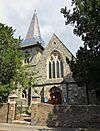 |
East Molesey 51°23′55″N 0°21′13″W / 51.398597°N 0.353557°W |
Anglican | II | Nothing remains of the 12th-century church here. The current building, designed by Thomas Talbot Bury, was built between 1864 and 1867. It is in the Early English Gothic Revival style with a stone west tower. | |
| St Paul's Church (More images) |
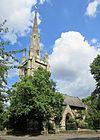 |
East Molesey 51°24′18″N 0°21′13″W / 51.404947°N 0.353660°W |
Anglican | II | St Paul's was built in 1854–56 because the old St Mary's Church was too small for the growing population. The tall spire was added in 1888. It's a Kentish ragstone church in the Perpendicular Gothic Revival style. | |
| East Molesey Methodist Church (More images) |
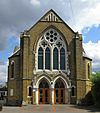 |
East Molesey 51°24′04″N 0°21′15″W / 51.401240°N 0.354046°W |
Methodist | – | Methodists started meeting in East Molesey in 1847. The current yellow-brick chapel, designed by Alexander Lauder, opened in 1877. It cost £1,175 to build and could hold 350 people. | |
| House of Prayer | East Molesey 51°23′54″N 0°21′41″W / 51.398273°N 0.361328°W |
Non-denominational | – | This building, originally a house from around 1900, was bought by the Sisters of the Christian Retreat in 1934. It became a school and later a Christian retreat. It was officially registered as a place of worship in July 1995. | ||
| St Barnabas' Church (More images) |
 |
East Molesey 51°24′11″N 0°21′24″W / 51.403138°N 0.356546°W |
Roman Catholic | – | Nuns from France bought a house here in 1905 and used it as a convent. A temporary chapel was set up next to it, and then the current St Barnabas' Church was built in 1931. It is a "plain but attractive" Romanesque Revival brick church. | |
| Christ Church (More images) |
 |
Esher 51°22′12″N 0°22′01″W / 51.370016°N 0.366866°W |
Anglican | II | Benjamin Ferrey designed Esher's new parish church in 1853–54. It is a large Early English Gothic Revival stone building with a tall west tower and spire. The stained glass in the east window was designed by Ninian Comper in 1909. | |
| Esher Green Baptist Church (More images) |
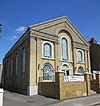 |
Esher 51°22′10″N 0°22′00″W / 51.369479°N 0.366706°W |
Baptist | – | This chapel, originally called Park Road Chapel, was built in 1869 for a Baptist group formed 17 years earlier. It closed in 1977 but reopened in 1983 as Esher Green Baptist Church. | |
| Friends Meeting House (More images) |
 |
Esher 51°22′06″N 0°21′53″W / 51.368316°N 0.364748°W |
Quaker | II | This meeting house was built around 1797. It has a simple "plain Georgian character" with arched windows and a pyramidal slate roof. The inside still has its original features. | |
| St Peter's Church (More images) |
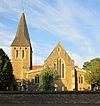 |
Hersham 51°21′51″N 0°24′08″W / 51.364136°N 0.402168°W |
Anglican | II | The first Anglican church in Hersham was built in 1839. It was replaced by the current church, designed by John Loughborough Pearson, in 1887. It is a stone church in the Early English Gothic Revival style with a tower and spire. | |
| Hersham Baptist Church (More images) |
 |
Hersham 51°22′28″N 0°23′30″W / 51.374515°N 0.391801°W |
Baptist | – | This building was originally a second Anglican church for Hersham, built in 1936. It was sold to a Baptist group in 1992 and reregistered as Hersham Baptist Church in 1994. | |
| Emmanuel Evangelical Church (More images) |
 |
Hersham 51°22′02″N 0°24′12″W / 51.367152°N 0.403297°W |
Non-denominational | – | This church was registered for marriages in September 1975. In 2002, it held two Sunday services and one on Wednesdays. | |
| All Saints Church (More images) |
 |
Hersham 51°22′00″N 0°24′04″W / 51.366532°N 0.401015°W |
Roman Catholic | – | This large brick church opened in June 1960. Construction started in 1959, designed by Lawrence Tomei and John Maxwell. | |
| St Christopher's Church (More images) |
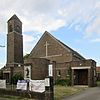 |
Hinchley Wood 51°22′48″N 0°19′57″W / 51.379947°N 0.332379°W |
Anglican | – | Hinchley Wood's Anglican church opened and was consecrated in 1953. | |
| Church of Jesus Christ of Latter-day Saints, Kingston Ward Chapel (More images) |
 |
Hinchley Wood 51°22′48″N 0°20′35″W / 51.379927°N 0.343082°W |
Latter-day Saint | – | This meetinghouse opened in 1978 and was registered in August of that year. | |
| St Mary's Church (More images) |
 |
Long Ditton 51°22′50″N 0°19′01″W / 51.380527°N 0.316833°W |
Anglican | II | A 12th-century church was replaced in 1776, and then again by the current building in 1880, designed by George Edmund Street. It is made of stone with slate roofs and has a double bell-cot. | |
| St Mary's Church (More images) |
 |
Oatlands 51°22′19″N 0°25′41″W / 51.371814°N 0.427992°W |
Anglican | II | This church was built between 1861 and 1862. It is in the Early English Gothic Revival style with a battlemented corner tower. | |
| First Church of Christ, Scientist, Walton and Weybridge (More images) |
 |
Oatlands 51°22′47″N 0°26′00″W / 51.379604°N 0.433417°W |
Christian Scientist | – | This Christian Science church was registered for worship in December 1946. | |
| North West Surrey Synagogue (More images) |
 |
Oatlands 51°22′21″N 0°26′18″W / 51.372562°N 0.438261°W |
Jewish (Reform) | – | The first Jewish presence in Weybridge was a school in 1937. The current synagogue, a former school gymnasium, opened in 1985. | |
| St Andrew's Church (More images) |
 |
Oxshott 51°19′53″N 0°21′44″W / 51.331409°N 0.362356°W |
Anglican | L | Anglican services were held in a school until a tin tabernacle was built in 1905. The current St Andrew's Church, designed by Caröe and Passmore, was consecrated in 1912. | |
| St Mary's Church (More images) |
 |
Stoke d'Abernon 51°18′50″N 0°22′52″W / 51.313913°N 0.381199°W |
Anglican | I | Much of this church is from the Saxon or Norman periods. It has a large nave, a north aisle added around 1190, and the Norbury Chapel built in 1490. | |
| Cobham United Church (More images) |
 |
Stoke d'Abernon 51°19′23″N 0°23′32″W / 51.322986°N 0.392308°W |
United Reformed Church and Methodist | – | The current building dates from 1962. It was known as Cobham United Reformed Church until the town's Methodist group joined in 2018. | |
| St Nicholas' Church (More images) |
 |
Thames Ditton 51°23′33″N 0°19′58″W / 51.392556°N 0.332746°W |
Anglican | I | St Nicholas' Church is mostly from the 1200s, with some older parts inside. It has a large, wide tower at the west end. The south aisle was rebuilt in 1864. | |
| Kingston Liberal Synagogue (More images) |
 |
Thames Ditton 51°23′10″N 0°19′22″W / 51.386120°N 0.322692°W |
Jewish (Liberal) | – | This community was formed in 1967 and bought the current building in Long Ditton in 1976. | |
| New Apostolic Church (More images) |
 |
Thames Ditton 51°23′22″N 0°19′22″W / 51.389387°N 0.322884°W |
New Apostolic Church | – | This church was registered in September 1978. | |
| Church of Our Lady of Lourdes (More images) |
 |
Thames Ditton 51°23′19″N 0°20′48″W / 51.388595°N 0.346799°W |
Roman Catholic | – | Designed by D.A. Reid, this new Catholic church opened in 1965. It is a circular building of brick and concrete with a shallow domed roof, and a large sculpture of Christ above the entrance. | |
| Thames Ditton United Reformed Church (More images) |
 |
Thames Ditton 51°23′25″N 0°20′19″W / 51.390211°N 0.338491°W |
United Reformed Church | – | A Dissenting chapel opened in 1804. The current building started in 1899 and opened in November of that year. It closed in 1938 but reopened in 1947. | |
| St Mary's Church (More images) |
 |
Walton-on-Thames 51°23′14″N 0°25′04″W / 51.387089°N 0.417696°W |
Anglican | I | This church existed by the 12th century, with some Norman parts still visible. The chancel was extended in the 1300s, and aisles were added. It contains a large, beautiful monument by Louis-François Roubiliac. | |
| St John's Church (More images) |
 |
Walton-on-Thames 51°22′56″N 0°24′00″W / 51.382357°N 0.400084°W |
Anglican | – | Walton's second Anglican church opened in 1953 and serves the eastern part of the town. | |
| Walton Baptist Church (More images) |
 |
Walton-on-Thames 51°23′04″N 0°24′59″W / 51.384511°N 0.416520°W |
Baptist | – | The town's Baptist church was built in 1901 and registered five years later. | |
| Walton-on-Thames Methodist Church (More images) |
 |
Walton-on-Thames 51°23′18″N 0°25′03″W / 51.388404°N 0.417422°W |
Methodist | L | This church, originally Wesleyan, dates from 1887 and replaced an older building. It has a corner tower with a spire. | |
| Cornerstone The Church (More images) |
 |
Walton-on-Thames 51°22′23″N 0°24′56″W / 51.373171°N 0.415539°W |
Non-denominational | – | This Charismatic Evangelical church was founded in 1990 and has been in its current building, a former car showroom, since around 2015. | |
| St Erconwald's Church (More images) |
 |
Walton-on-Thames 51°23′08″N 0°24′48″W / 51.385689°N 0.413361°W |
Roman Catholic | – | The original church building (now the parish hall) was designed in 1905. It was replaced by Wallace J. Gregory's "substantial brick church" in 1937, with work continuing until 1951. | |
| Walton Christian Spiritualist Church (More images) |
 |
Walton-on-Thames 51°22′31″N 0°24′26″W / 51.375315°N 0.407270°W |
Spiritualist | – | This church was founded in the mid-1930s. A license for marriages was given in August 1982. | |
| St Andrew's United Reformed Church (More images) |
 |
Walton-on-Thames 51°22′54″N 0°24′51″W / 51.381601°N 0.414074°W |
United Reformed Church | – | Presbyterians started meeting in Walton-on-Thames in 1928, using a local theatre. A church hall was built in 1931, which has been used for worship ever since. | |
| St George's Church (More images) |
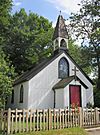 |
West End 51°21′40″N 0°22′55″W / 51.361131°N 0.381944°W |
Anglican | L | This tin tabernacle (a church made of corrugated iron) has been used as a chapel since at least 1911 and is still active today. | |
| St Peter's Church (More images) |
 |
West Molesey 51°24′11″N 0°22′18″W / 51.403084°N 0.371569°W |
Anglican | II | The 16th-century tower and 15th-century font are the oldest parts of this church. The rest was rebuilt in 1843 using yellow brick. | |
| Kingdom Hall (More images) |
 |
West Molesey 51°24′02″N 0°22′14″W / 51.400579°N 0.370503°W |
Jehovah's Witnesses | – | This building serves the Jehovah's Witnesses groups in West Molesey and Walton-on-Thames. It was registered for worship in April 1971. | |
| All Saints Church (More images) |
 |
Weston Green 51°23′03″N 0°20′58″W / 51.384069°N 0.349394°W |
Anglican | II | A chapel opened here in 1901. The new church, designed by Edward Maufe (who also designed Guildford Cathedral), was built in 1939. It is in the Romanesque Revival style with a tall bell-tower. | |
| St James's Church (More images) |
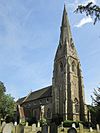 |
Weybridge 51°22′18″N 0°27′40″W / 51.371570°N 0.461030°W |
Anglican | II* | The old church here was replaced by this large new building in 1848, designed by John Loughborough Pearson. It is in the Early English Gothic Revival style with a tall tower and spire. | |
| World Mission Korean Presbyterian Church (More images) |
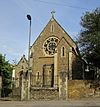 |
Weybridge 51°21′59″N 0°27′36″W / 51.366438°N 0.459995°W |
Korean Presbyterian | II* | This building was originally St Charles Borromeo Catholic Church, built in 1880–81. It became a Korean Presbyterian church in 1997 after a new Catholic church was built. | |
| Weybridge Methodist Church (More images) |
 |
Weybridge 51°22′11″N 0°27′46″W / 51.369604°N 0.462721°W |
Methodist | – | This red-brick church was built for Wesleyans and could hold 200 people. It was registered in January 1903. | |
| Church of Christ the Prince of Peace (More images) |
 |
Weybridge 51°22′28″N 0°27′38″W / 51.374546°N 0.460471°W |
Roman Catholic | – | Weybridge's new Catholic church opened in 1989, replacing older churches. It includes items from the previous churches. | |
| Weybridge United Reformed Church (More images) |
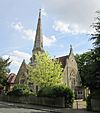 |
Weybridge 51°22′05″N 0°26′47″W / 51.368080°N 0.446443°W |
United Reformed Church | II | This church was founded in 1864. The foundation stone was laid in July 1864, and the first service was in May 1865. It is a Gothic Revival style church. | |
| St Mark's Church (More images) |
 |
Whiteley Village 51°21′10″N 0°25′48″W / 51.352914°N 0.430104°W |
Anglican | II | Walter Tapper designed this church in 1912 for the model village. Its Early English Gothic Revival design is different from the village's Arts and Crafts style. |
Former Places of Worship
| Name | Image | Location | Religion/ Group |
Grade | Notes | Refs |
|---|---|---|---|---|---|---|
| Ebenezer Chapel | 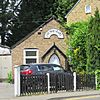 |
Claygate 51°21′27″N 0°20′16″W / 51.357452°N 0.337790°W |
Strict Baptist | – | This chapel was built in 1860 for Strict Baptists. It is now a house. | |
| Emmanuel Hall |  |
Claygate 51°21′29″N 0°20′04″W / 51.358008°N 0.334528°W |
Non-denominational | – | This building was registered for marriages in October 1941. It is now used as a youth centre by Holy Trinity parish church. | |
| Cobham Methodist Church (More images) |
 |
Cobham 51°19′44″N 0°24′33″W / 51.328849°N 0.409269°W |
Methodist | – | This church closed on May 20, 2018, when its members joined the United Reformed Church. It was originally a Sunday school from the 1930s. | |
| Cobham Gospel Hall (More images) |
 |
Cobham 51°19′59″N 0°24′44″W / 51.333036°N 0.412228°W |
Open Brethren | – | This Gospel hall was registered in September 1941. It closed in 2006 and was later converted into temporary classrooms for Cobham Free School. | |
| Ebenezer Baptist Chapel (More images) |
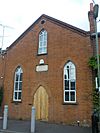 |
Cobham 51°19′45″N 0°24′36″W / 51.329072°N 0.409995°W |
Strict Baptist | – | This chapel opened in 1873 for Strict Baptist worshippers. It closed in 1941 and was turned into a house. | |
| Molesey Baptist Chapel | 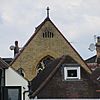 |
East Molesey 51°24′09″N 0°20′39″W / 51.402583°N 0.344116°W |
Baptist | – | This chapel was only used for religious services for 10 years. It was built in 1886 but was sold and converted into commercial premises because of its location and cost. | |
| St George's Church (More images) |
 |
Esher 51°22′09″N 0°21′52″W / 51.369236°N 0.364466°W |
Anglican | I | Esher's original parish church was officially declared no longer needed in 1986. It is a "delightful" church from the 1540s. It contains many old monuments and memorials. | |
| Esher Methodist Chapel | 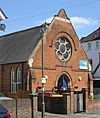 |
Esher 51°22′11″N 0°22′06″W / 51.369810°N 0.368428°W |
Methodist | – | This brick chapel was built for Wesleyan Methodists. It was registered for marriages in 1897 but closed in 2000 and is now a nursery school. | |
| Trinity United Reformed Church (More images) |
 |
Hersham 51°22′03″N 0°24′18″W / 51.367587°N 0.404987°W |
United Reformed Church | – | This church was founded in 1909. It closed in 1977 and was replaced by a smaller building in 1983. This building also closed in 2008 and is now a Montessori school. | |
| Oxshott Baptist Chapel | Oxshott 51°19′57″N 0°21′58″W / 51.332635°N 0.366244°W |
Baptist | – | This chapel was founded in 1873. It was the only church in Oxshott until St Andrew's Church opened. It closed in 1980. | ||
| Kingdom Hall |  |
Walton-on-Thames 51°23′33″N 0°24′41″W / 51.392382°N 0.411261°W |
Jehovah's Witnesses | – | This Kingdom Hall was built in 1963. It stopped being used in 1993 and is now a nursery school. | |
| The Sanctuary | Whiteley Village 51°20′56″N 0°25′47″W / 51.349026°N 0.429814°W |
Non-denominational | – | A chapel for Nonconformists was built in Whiteley Village in 1925–26. It is no longer used for worship, and the church group now meets in a different room in the village. |


